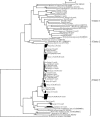Quantitative detection of the nosZ gene, encoding nitrous oxide reductase, and comparison of the abundances of 16S rRNA, narG, nirK, and nosZ genes in soils
- PMID: 16885263
- PMCID: PMC1538733
- DOI: 10.1128/AEM.00231-06
Quantitative detection of the nosZ gene, encoding nitrous oxide reductase, and comparison of the abundances of 16S rRNA, narG, nirK, and nosZ genes in soils
Abstract
Nitrous oxide (N2O) is an important greenhouse gas in the troposphere controlling ozone concentration in the stratosphere through nitric oxide production. In order to quantify bacteria capable of N2O reduction, we developed a SYBR green quantitative real-time PCR assay targeting the nosZ gene encoding the catalytic subunit of the nitrous oxide reductase. Two independent sets of nosZ primers flanking the nosZ fragment previously used in diversity studies were designed and tested (K. Kloos, A. Mergel, C. Rösch, and H. Bothe, Aust. J. Plant Physiol. 28:991-998, 2001). The utility of these real-time PCR assays was demonstrated by quantifying the nosZ gene present in six different soils. Detection limits were between 10(1) and 10(2) target molecules per reaction for all assays. Sequence analysis of 128 cloned quantitative PCR products confirmed the specificity of the designed primers. The abundance of nosZ genes ranged from 10(5) to 10(7) target copies g(-1) of dry soil, whereas genes for 16S rRNA were found at 10(8) to 10(9) target copies g(-1) of dry soil. The abundance of narG and nirK genes was within the upper and lower limits of the 16S rRNA and nosZ gene copy numbers. The two sets of nosZ primers gave similar gene copy numbers for all tested soils. The maximum abundance of nosZ and nirK relative to 16S rRNA was 5 to 6%, confirming the low proportion of denitrifiers to total bacteria in soils.
Figures






References
-
- Cavigelli, M. A., and G. P. Robertson. 2001. Role of denitrifier diversity in rates of nitrous oxide consumption in a terrestrial ecosystem. Soil Biol. Biochem. 33:297-310.
-
- Chèneby, D., S. Perrez, C. Devroe, S. Hallet, Y. Couton, F. Bizouard, G. Iuretig, J. C. Germon, and L. Philippot. 2004. Denitrifying bacteria in bulk and maize-rhizospheric soil: diversity and N2O-reducing abilities. Can. J. Microbiol. 50:469-474. - PubMed
-
- Coyle, C. L., W. G. Zumft, P. M. Kroneck, H. Korner, and W. Jakob. 1985. Nitrous oxide reductase from denitrifying Pseudomonas perfectomarina. Purification and properties of a novel multicopper enzyme. Eur. J. Biochem. 16:459-467. - PubMed
Publication types
MeSH terms
Substances
Associated data
- Actions
- Actions
- Actions
- Actions
- Actions
- Actions
- Actions
- Actions
- Actions
- Actions
- Actions
- Actions
- Actions
- Actions
- Actions
- Actions
- Actions
- Actions
- Actions
- Actions
- Actions
- Actions
- Actions
- Actions
- Actions
- Actions
- Actions
- Actions
- Actions
- Actions
- Actions
- Actions
- Actions
- Actions
- Actions
- Actions
- Actions
- Actions
- Actions
- Actions
- Actions
- Actions
- Actions
- Actions
LinkOut - more resources
Full Text Sources
Molecular Biology Databases

